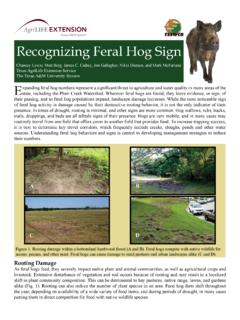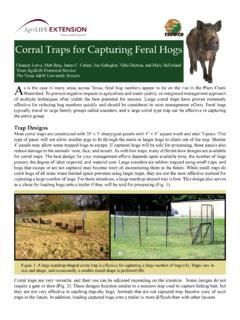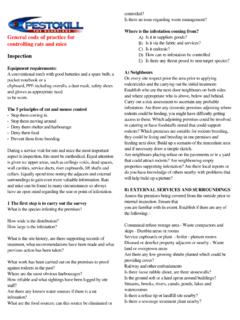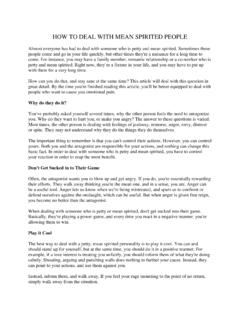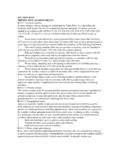Transcription of Placing and baiting feral hog traps - Coping with …
1 The increasing numbers of feralhogs in Texas are harmingwater quality, landscapes,gardens, native plant and animalcommunities, and agriculturalproduction in many areas of thestate. Two keys to success inmanaging feral hogs are trapplacement and pre- baiting . The landowner or managermust thoroughly understand theforaging behaviors and travelpatterns of feral hogs. Controlefforts will be more effective iflocal conditions and feral hogbehavior are properly placementIncrease your chances of suc-cess by Placing traps properly. Place them on oralong hog trails linking resources such as food,cover, and water (Fig.)
2 1). Aerial photographs can show how resourcesare distributed across the landscape, which willhelp you place the traps strategically. Photos canbe obtained through the Department ofAgriculture or software such as Google setting a trap, scout the property forhog sign: trails, scat, wallows, hog damage, andrubs, which are areas of mud rubbed on trees,posts, and utility poles. In areas where hogs areabundant, they will create visible paths (Fig. 2A). Often the easiest form of hog sign to locateand identify is the damage caused by , do not place a trap in these sites.
3 Ifyou place the trap where there is ongoing dam-age by hogs, the bait will compete with a foodsource that the hogs are already using, and hogstend to prefer a familiar food source. A better approach is to place traps alongtrails to and from these areas. Fence lines are of-ten good places to start. Hogs often create crawlsunder fences and leave mud or hair on fencewires when passing. If a trail is well establishedor has significant traffic, it may be heavilyeroded. In some cases, hogs may just be passingthrough one property to gain access to a feedingarea on another property.
4 If so, determine wherethe hogs are entering the property and set thetrap nearby (Fig. 2B). Use landscape features tohide the trap as much as possible, or set the trapnear a fence if no hog trails are evident, ideal trapPLACINGANDBAITINGFERALHOGTRAPS|1 *Former Extension Assistant; Extension Program Specialist; Extension Program Specialist II; Assistant Extension Wildlife Specialist; Professor and Extension Soil Fertility Specialist; and Associate Professor and Extension Wildlife SpecialistAll of The Texas A&M University System L-552602-11 Placing and BaitingFeral Hog TrapsChancey Lewis, Matt Berg, Nikki Dictson, Jim Gallagher, Mark McFarland, and James C.
5 Cathey*Figure 1 feral hogs traveled across this field from cover to a feeding area. Fencelines where these trails converge are excellent locations for large |PLACINGANDBAITINGFERALHOGTRAPS locations still exist. feral hogs often travel alongcreeks and roads and use cover near overgrownfence lines while traveling. These areas funnelferal hog travel and provide excellent places toset corral traps , particularly if they lead to afeeding area. Other good sites for corral traps are areas fre-quented by feral hogs throughout the year, suchas watering holes, wallowing areas, and utilitypoles (Fig.)
6 3). If possible, place the hog traps upwind frombedding areas used by the animals during theday. This placement will allow the wind to dis-perse the scent of bait to attract hogs fromfarther away. Bait typesNotoxicants, fertility agents, or biologicalcontrol chemicals are legally registered for useagainst feral hogs in the United States. It is ille-gal to use toxicants with feral hog baits; baitingstrategies should lure the animals into corral orbox traps . feral hogs are omnivores; they eat bothFigure 2A woodland edge and a road converge with a meandering creek (A).
7 This setup offers an excellent trap site. feral hogsfrequent this utility pole for rubbing and scratching (B), providing another area for a trap nearby. Figure 3 BAA well-traveled feral hog trail passes under a fence between two properties (A).Here, a large corral trap is an effective option (B). This trap is set along a knownferal hog trail and is equipped with saloon-type doors on both |3plants and animals, and a wide array of baitscan be used with success. Common baits includewhole corn, livestock cubes, carrion, sour grain,and commercial hog attractant scents.
8 If corn is used, nontarget animals such asdeer may be captured. Soaking the corn in waterfor 1 week will cause it to sour, and the strongodor will deter other animals from feeding on of bait type, trapping may be less successful if acorns or other readily availablenatural foods are bait recipePre- baiting is vital for trap success. If wholecorn does not attract feral hogs, use the follow-ing recipe developed by the Georgia Departmentof Natural Resources: 150 pounds of corn 8 pounds of sugar 1 packet of yeast 4 or 5 packets of grape, strawberry, or rasp-berry flavored gelatin or drink powderPlace the corn in a 40 gallon metal trash canand fill it with water to 3 to 4 inches above thecorn.
9 Mix in all the other ingredients. Place the trash can in the sun with the lid secured. Stir it with a shovel or paddle daily for10 to 14 days. Take care not to spill the product on yourclothes. Ladle the bait in and around the trapand replenish it as baits Corn fermented in beer Bread fermented in water Dry dog food Ripe fruit Commercially available baits and scents FlourPre-baitingFor all feral hog traps , it is critical to pre-bait that is, to place bait in the trap for aperiod before setting the trap. Pre- baiting will attract animals and accustom them to enteringthe trap Start by Placing bait near the opening andinside the trap (Fig.)
10 4B).2. As the hogs begin to routinely enter the trap,continue pre- baiting inside the trap for a fewmore days to ensure the entire sounder(group) is comfortable entering the A game camera is useful for monitoring thenumber of hogs entering the trap, and itFigure 4A game camera is useful for moni-toring feral hogactivity near thesite of a trap (A). Photographs canindicate the num-ber of hogs in thearea and the besttime to set thetrap. Pre-baitingincreases theprobability ofcatching a largenumber of by placingbait outside andthrough the gateopening of thetrap (B).

